Ninth Avenue (Manhattan)
| Columbus Avenue (59th–110th Streets) Morningside Drive (north of 110th Street) | |
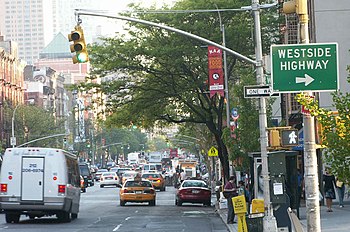 The avenue in Hell's Kitchen
| |
| Owner | City of New York |
|---|---|
| Maintained by | NYCDOT |
| Length | 5.7 mi (9.2 km) |
| Location | Manhattan, New York City |
| South end | Greenwich Street |
| North end | Broadway above West 220th Street in Inwood, Manhattan |
| East |
Eighth Avenue (below 59th Street) Central Park West (59th–110th Streets) |
| West |
Tenth Avenue (below 59th Street) Amsterdam Avenue (above 59th Street) |
| Construction | |
| Commissioned | March 1811 |
Ninth Avenue, known as Columbus Avenue between West 59th and 110th Streets, is a thoroughfare on the West Side of Manhattan in New York City, United States. Traffic runs downtown (southbound) from the Upper West Side to Chelsea. Two short sections of Ninth Avenue also exist in the Inwood neighborhood, carrying two-way traffic.
Description
Ninth Avenue originates just south of West 14th Street at Gansevoort Street in the West Village, and extends uptown for 48 blocks until its intersection with West 59th Street, where it becomes Columbus Avenue – named after Christopher Columbus. It continues without interruption through the Upper West Side to West 110th Street, where its name changes again, to Morningside Drive, and runs north through Morningside Heights to West 122nd Street.
A one-block stretch of Ninth Avenue between 15th and 16th Streets is also signed as "Oreo Way". The first Oreo cookies were manufactured in 1912 at the former Nabisco headquarters on that block.
The portion of the avenue between 14th and 31st Streets was remodeled in 2008 with a bicycle lane between the eastern curb and the parking lane, followed by another portion between 77th and 96th Streets in 2011.
Above the Lincoln Square neighborhood—where the ABC television network houses its corporate headquarters in a group of rehabilitated and modern buildings—Columbus Avenue passes through the Central Park West Historic District, stretching from 67th/68th Streets to 89th Street. There, the avenue presents a unified streetscape of 5- to 7-story tenement buildings of brick and brownstone with discreet Romanesque and Italianate details, employing cast terracotta details and panels and courses of angle-laid brickwork. Many ornate tin cornices remain. The buildings are separated in mid-block by the narrowest of access alleys, giving glimpses of Ailanthus foliage in the side-street yards. The repeated designs of three or four commercial speculative builders, using the same features and detailing, add to the avenue's architectural unity. There are several generously scaled pre-World War I apartment buildings and the former Endicott Hotel, as well as a small commercial block from the office of McKim, Mead, and White at 72nd Street.
Between 77th and 81st Streets, Columbus Avenue borders the American Museum of Natural History and Theodore Roosevelt Park.
Ninth Avenue reappears in the Inwood neighborhood as a short two-way street in two segments interrupted by the New York City Subway's 207th Street Yard. It runs from West 201st Street to West 208th Street, dead-ending at Inwood North Cove Park at the Harlem River, then picks up again at West 215th Street, and terminates at Broadway between West 220th Street and the Broadway Bridge, at the location where West 221st Street would normally be. The addresses along this upper stretch from 201st Street to Broadway are continuous with the lower portion of Ninth Avenue.
History
The Ninth Avenue Elevated was a passenger train that ran above Ninth Avenue, beginning in the nineteenth century. The lease for the line was assumed by the Interborough Rapid Transit Company (IRT) on April 1, 1903. The line ran until it was closed and dismantled in 1940, following the purchase of the IRT by the City of New York, as it was made redundant by the city's Eighth Avenue subway line.
Ninth Avenue and Columbus Avenue were converted to carry one-way traffic southbound in two stages. South of its intersection with Broadway, the avenue was converted on November 6, 1948. The remaining stretch, to 110th Street, was converted on December 6, 1951.
In 2007, Ninth Avenue became the first major north-south avenue in Manhattan with a protected bike lane. The bike lane initially extended only from 23rd to 16th Street. A protected bike lane on Columbus Avenue was built between 96th and 77th Street in 2010–2011; the bike lane led to increases in vehicular speeds, since drivers were no longer stuck behind bicyclists. After a $231 million project that replaced some of the water pipes under Ninth Avenue, the segment between 59th and 50th Street was narrowed to three travel lanes in March 2023, and a painted sidewalk and protected bike lane were added.
The Ninth Avenue International Food Festival street fair is held every year in May.
Transportation
Ninth Avenue (Columbus Avenue) is served primarily by the M7 between 66th Street and 106th Street while the M11 between Cathedral Parkway and 14th Street. The M12, M79 SBS, M34A SBS, and M14D+ Select Bus runs on short portions of the street.
The 1 (2 during late nights) have a station on Columbus Avenue on the IRT Broadway - Seventh Avenue Line at 66th Street and Broadway
Points of interest
|
|
Gallery
-
 The Hotel Gansevoort at 19 Ninth Avenue
The Hotel Gansevoort at 19 Ninth Avenue -
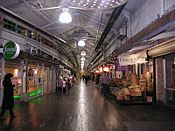 The interior of Chelsea Market, the main entrance of which is on Ninth Avenue between 15th-16th Streets
The interior of Chelsea Market, the main entrance of which is on Ninth Avenue between 15th-16th Streets -
 The Maritime Hotel at 16th-17th Streets
The Maritime Hotel at 16th-17th Streets -
 The Fulton Houses of the New York City Housing Authority at 18th Street
The Fulton Houses of the New York City Housing Authority at 18th Street -
 The Penn South housing complex at 25th Street
The Penn South housing complex at 25th Street -
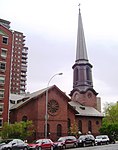 The Church of the Holy Apostles at 28th Street
The Church of the Holy Apostles at 28th Street -
B&H Photo Video at 34th Street
-
 The Ninth Avenue International Food Festival
The Ninth Avenue International Food Festival -
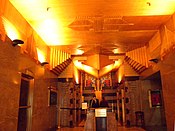 The lobby of the Film Center Building at 44th-45th Streets
The lobby of the Film Center Building at 44th-45th Streets -
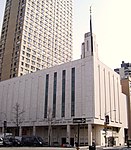 The Manhattan New York Temple of the Church of Jesus Christ of Latter-day Saints at 65th-66th Streets
The Manhattan New York Temple of the Church of Jesus Christ of Latter-day Saints at 65th-66th Streets
In popular culture
- Ninth Avenue is the setting of Saul Steinberg's View of the World from 9th Avenue.
- In the TV show Seinfeld, the street set on which most of the street scenes were filmed was based on Columbus Avenue.
- In the play The Zoo Story by Edward Albee, Jerry claims to live between Columbus Avenue and Central Park.
See also
- New York City portal









